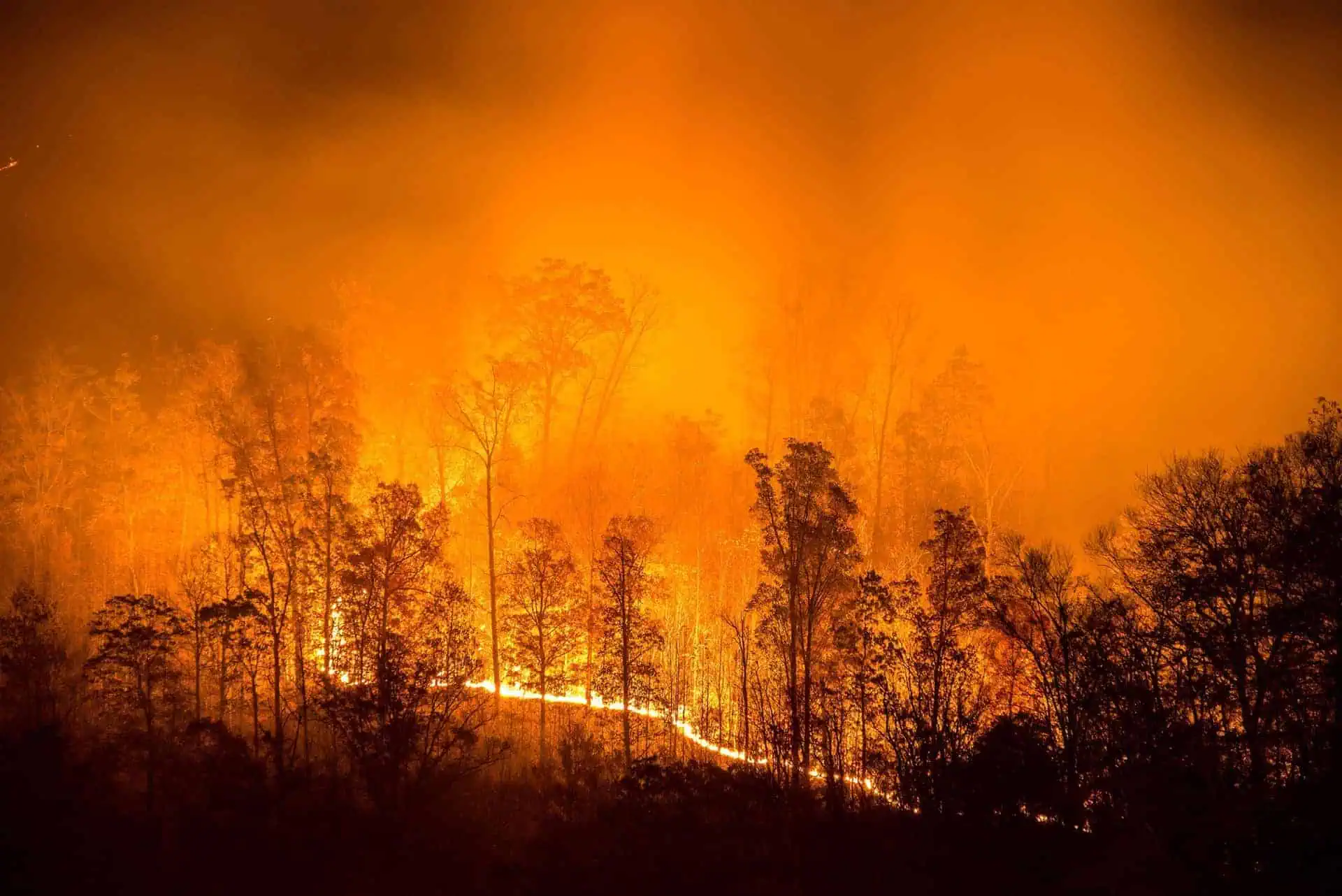Maui Wildfires Lawsuit: What Damages Can Be Claimed?
- Last Updated: June 12th, 2025

Attorney Jessica Paluch-Hoerman, founder of TruLaw, has over 28 years of experience as a personal injury and mass tort attorney, and previously worked as an international tax attorney at Deloitte. Jessie collaborates with attorneys nationwide — enabling her to share reliable, up-to-date legal information with our readers.
Legally Reviewed
This article has been written and reviewed for legal accuracy and clarity by the team of writers and legal experts at TruLaw and is as accurate as possible. This content should not be taken as legal advice from an attorney. If you would like to learn more about our owner and experienced injury lawyer, Jessie Paluch, you can do so here.
Fact-Checked
TruLaw does everything possible to make sure the information in this article is up to date and accurate. If you need specific legal advice about your case, contact us by using the chat on the bottom of this page. This article should not be taken as advice from an attorney.
Overview of Damages in the Maui Wildfire Lawsuit
Question: What damages can be claimed in the Maui Wildfire Lawsuit?
Answer: The Maui Wildfires Lawsuit seeks compensation for a wide range of damages, including losses to public infrastructure, fire response costs, revenue losses, increased costs, environmental damages, and losses of historical or cultural landmarks — amongst many other possible damages.
Intro to the Maui Wildfire Lawsuits
The County of Maui has filed a lawsuit against the Hawaiian Electric Co., alleging negligence on the part of the company that led to the deadliest U.S. wildfire in the past century.
The county has estimated the damages from the fires in Lahaina and Kula to be around $5.5 billion.
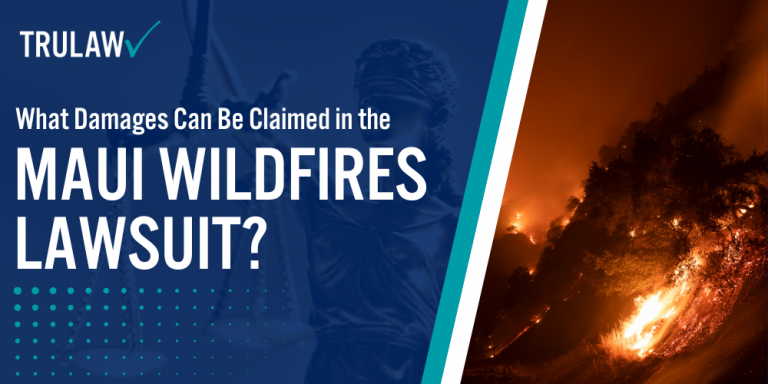
The lawsuit accuses Hawaiian Electric of negligence for failing to power down its power lines and other electric equipment.
This failure occurred despite a red flag warning from the National Weather Service on August 7th, indicating an increased risk of fire danger.
The county argues that the company’s failure to act on this warning directly contributed to the devastating fires.
Furthermore, Hawaiian Electric has called the complaint “factually and legally irresponsible.”
The legal implications of this lawsuit are significant.
If the court finds in favor of the County of Maui, it could set a precedent for utility companies’ responsibilities during extreme weather conditions.
Table of Contents
Public Infrastructure Damage in the Maui Wildfire Lawsuit
The County of Maui lawsuit against Hawaiian Electric Co. includes claims for extensive damage to public infrastructure caused by the wildfires.
This includes roads, bridges, public buildings, and utilities, all of which are essential for the functioning of the county and the well-being of its resident
Accountability and Legal Implications
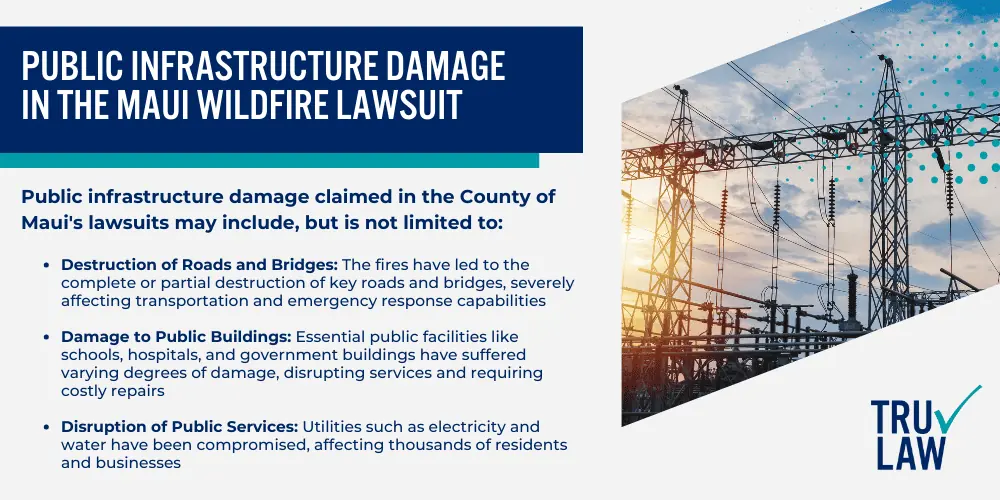
The lawsuit against Hawaiian Electric and its subsidiaries alleges that the utility company’s negligence caused the devastating wildfires that led to these damages.
The company’s shares jumped nearly 40% after they claimed they were not responsible for the wildfires, adding another layer of complexity to the lawsuit.
Public infrastructure damage claimed in the County of Maui’s lawsuits may include, but is not limited to:
- Destruction of Roads and Bridges: The fires have led to the complete or partial destruction of key roads and bridges, severely affecting transportation and emergency response capabilities.
- Damage to Public Buildings: Essential public facilities like schools, hospitals, and government buildings have suffered varying degrees of damage, disrupting services and requiring costly repairs.
- Disruption of Public Services: Utilities such as electricity and water have been compromised, affecting thousands of residents and businesses.
Financial Impact
The destruction of public infrastructure not only disrupts daily life but also requires significant resources for repair and reconstruction.
The lawsuit claims these damages, and the financial burden falls heavily on the County of Maui, which is already grappling with other types of losses such as revenue and increased operational costs.
Long-term Consequences
The long-term impact of these damages extends beyond immediate repair costs.
The destruction has a cascading effect on the community, affecting everything from property values to insurance rates.
Moreover, the loss of critical infrastructure can have lasting implications for the economic and social well-being of the County of Maui.
Assessing the Maui Wildfire Lawsuit Fire Response Costs
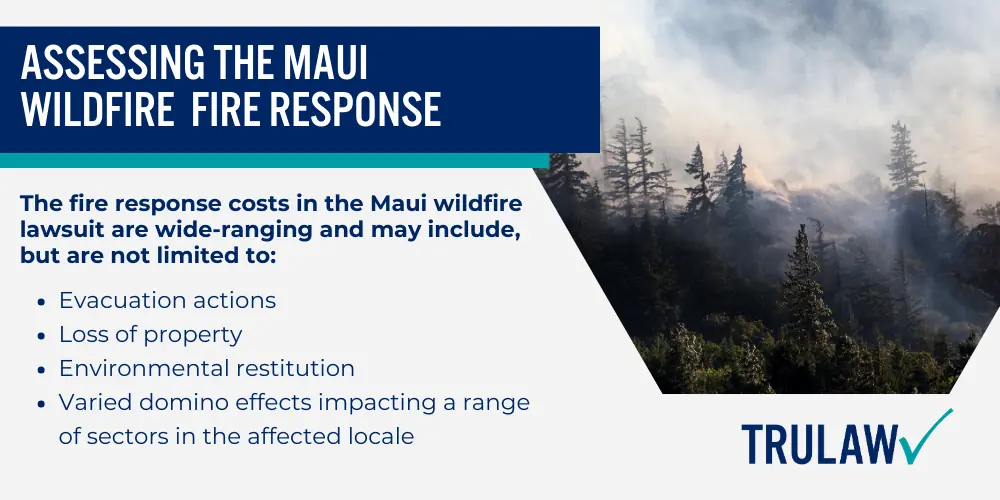
The final figure, to be contested in the ongoing Maui lawsuit, is yet to be concluded as investigations and discussions continue.
The fire response costs in the Maui wildfire lawsuit are wide-ranging and may include, but are not limited to:
- Evacuation actions
- Loss of property
- Environmental restitution
- Varied domino effects impacting a range of sectors in the affected locale.
In the Maui lawsuit, the county asserts a claim for the recovery of such fire response costs against Hawaiian Electric Co., stating that resources had to be unduly redirected toward mitigating the fire once it began to protect local communities.
The costs of fire response measures includes, but is not limited to:
- Firefighter deployment
- Emergency evacuation processes
- Air and ground equipment
- Evacuation actions
Beyond this, there are also longer-term costs like property repair or replacement, environmental remediation, and support for affected communities.
An essential aspect of recovering such costs is the robust documentation and tracking of all wildfire-associated expenditures.
The final figure, to be contested in the ongoing Maui lawsuit, is yet to be concluded as investigations and discussions continue.
An accurate calculation of fire response costs is critical for the County of Maui in establishing a realistic and fair compensation claim against Hawaiian Electric Co.
This endeavor will require comprehensive data collection, collation, and presentation by the involved parties’ legal and accounting teams.
While assessing fire response costs in the Maui wildfire lawsuit, the primary factors under consideration will be:
- Establishing the grounds of negligence
- Reckoning the costs directly and indirectly associated
- Accurately presenting the facts in court
In the face of current disagreements and ongoing investigations, fast resolution seems unlikely.
Instead, the success of the lawsuit may hinge on whether Maui County can establish Hawaiian Electric Co.’s negligence and justify the full cost recovery from the company.
This case serves as an essential exploration into the attribution of liabilities and costs associated with significant wildfire incidents, setting a precedent for future lawsuits of this nature.
The County of Maui: Revenues Losses
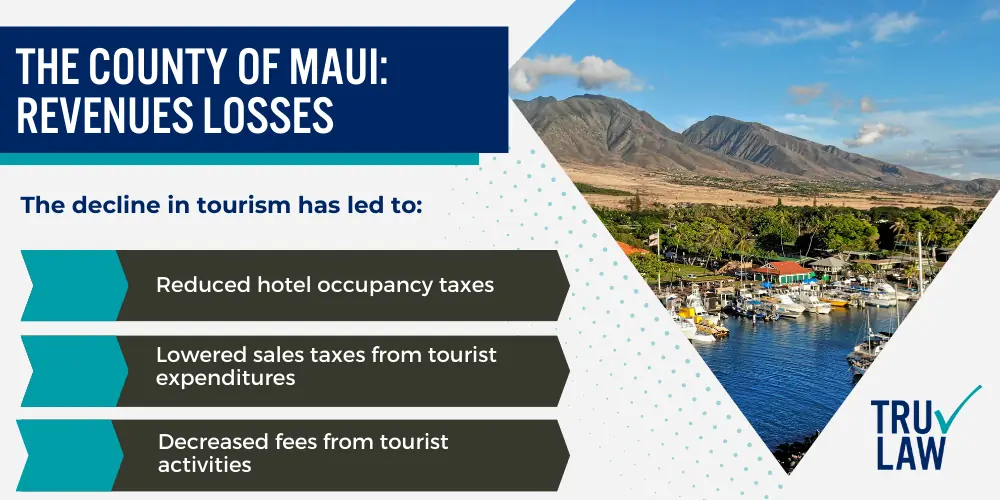
In addition to these direct costs, the County of Maui is also seeking compensation for losses to revenues and increased costs.
The fires led to a disruption in the county’s economic activities.
Furthermore, the county has had to incur increased costs in the aftermath of the fires, including cleanup costs and the cost of repairing and rebuilding damaged infrastructure.
Tourism-Related Revenue Loss
Tourism serves as a vital economic pillar for the county.
The wildfires have tarnished the county’s natural allure and infrastructure, thereby discouraging tourist visits.
The decline in tourism has led to:
- Reduced hotel occupancy taxes
- Lowered sales taxes from tourist expenditures
- Decreased fees from tourist activities
Property Tax Revenues
The fires have inflicted severe damage on both residential and commercial properties.
This has likely resulted in the depreciation of property values and the subsequent reduction in property tax revenues.
Beyond the direct losses, the wildfires have disrupted the county’s economic fabric.
Implication of Hawaiian Electric Co.
Hawaiian Electric Co. (HECO), provides the overwhelming majority of electricity to the state of Hawaii.
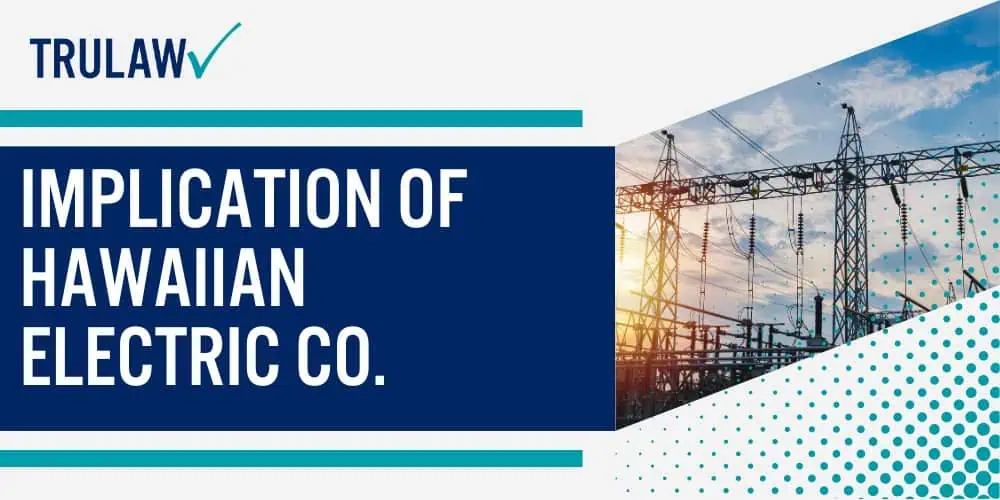
As a leading utility company in Lahaina, they’re responsible for maintaining the power grid and ensuring that electrical power flows safely through transmission lines strung across telephone poles.
Role in the Wildfire’s Origin
There have been discussions suggesting that fallen power lines may have been the trigger for the Maui wildfire.
High winds are known to cause such incidents, particularly when utility companies have not adequately secured their electrical wires.
This situation is comparable to having matches near a haystack, where a single gust of wind could lead to a fire.
In this instance, there are accusations of negligence or misconduct on the part of HECO.
Some individuals argue that if the company had implemented proper measures to secure their electrical equipment in high wind conditions, the severe wildfire could have potentially been avoided.
Impact on Reputation and Business Operations
The recent incident has resulted in considerable scrutiny of HECO, leading to a significant impact on their reputation.
The negative response to the incident has been substantial and ongoing.
The company’s business operations have been adversely affected by the incident as well.
The ongoing investigations and potential lawsuits have created a challenging environment for the electric company.
The current circumstances suggest that the company is facing a difficult period.
Submitting Claims in the Maui Wildfire Lawsuit
People who experienced financial losses and non-tangible damages may be eligible to file a claim.
This often involves demonstrating that there was a lack of a sufficient mitigation plan in place.
To put it plainly, a claim cannot be submitted solely based on loss experienced in the fire.
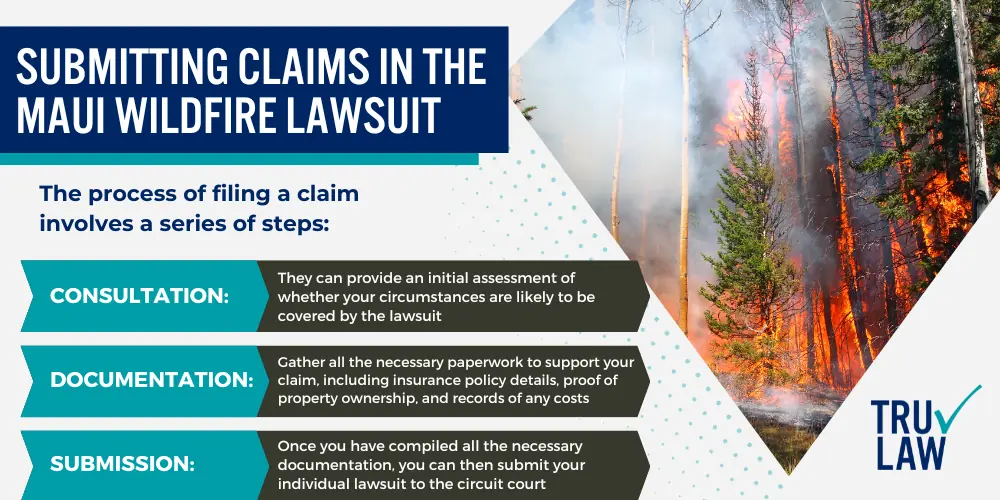
Establishing Your Claim
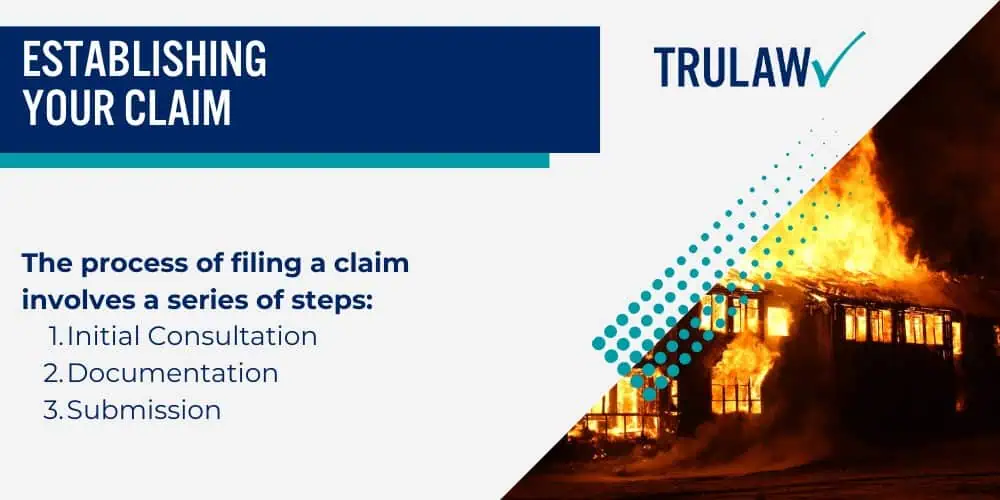
The process of filing a claim involves a series of steps:
- Initial Consultation: They can provide an initial assessment of whether your circumstances are likely to be covered by the lawsuit.
- Documentation: The next step involves gathering all the necessary paperwork to support your claim. This includes insurance policy details, proof of property ownership, and records of any costs incurred as a result of property damage.
- Submission: Once you have compiled all the necessary documentation, you can then submit your individual lawsuit to the circuit court.
Importance of Timeliness
Adherence to deadlines is critical in this process.
Each case comes with its own set of deadlines for filing claims.
Failure to meet these deadlines can result in your claim being dismissed.
Potential Challenges
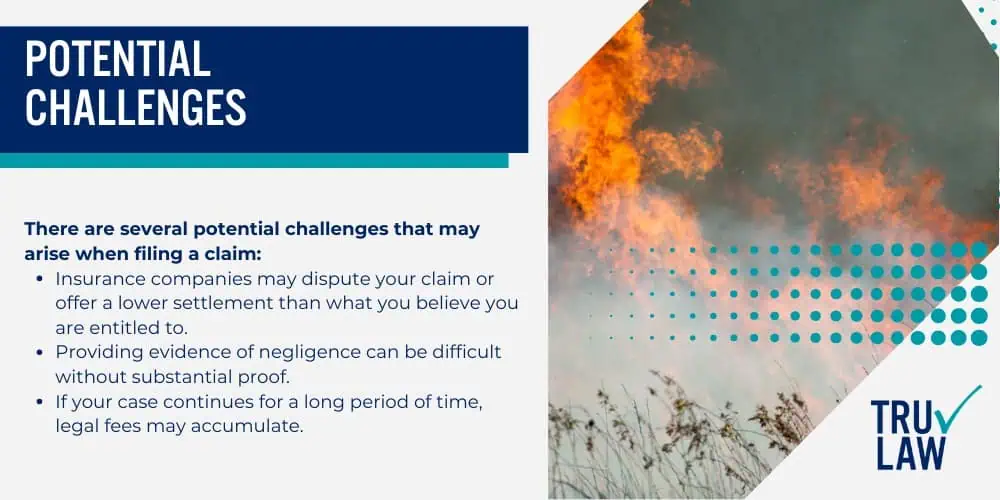
There are several potential challenges that may arise when filing a claim:
- Insurance companies may dispute your claim or offer a lower settlement than what you believe you are entitled to.
- Providing evidence of negligence can be difficult without substantial proof.
- If your case continues for a long period of time, legal fees may accumulate.
However, these potential challenges should not discourage you from pursuing your claim.
With the right legal advice and determination, it is possible to overcome these hurdles and secure compensation for damages caused by the Maui wildfire incident.
The Plaintiff's Claims in the Maui Wildfire Lawsuit
The central contention of the lawsuit is that Hawaiian Electric failed to adequately maintain their equipment.
This alleged negligence, the county argues, was the cause of a wildfire that resulted in substantial damage across a large area of the county.
The impact of this incident was significant, affecting residents for a duration exceeding one month.
Investigating into Negligence
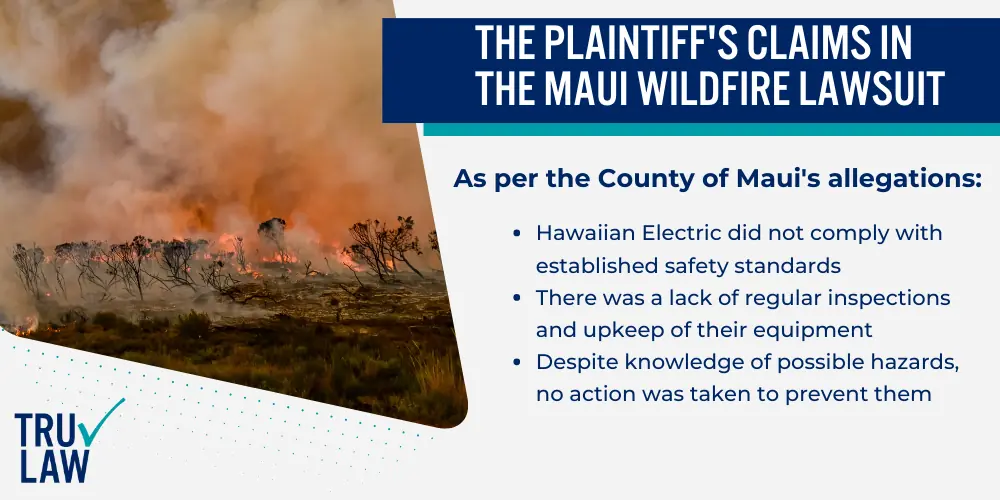
The term “negligence” as used by Maui County in their claim against Hawaiian Electric, requires further clarification.
As per the County of Maui’s allegations:
- Hawaiian Electric did not comply with established safety standards.
- There was a lack of regular inspections and upkeep of their equipment.
- Despite knowledge of possible hazards, no action was taken to prevent them.
The objective here is not merely to assign blame, but to ensure accountability for actions or inactions.
If these allegations are substantiated, it would indicate a disregard for public safety on the part of Hawaiian Electric.
Damages Sought
In the lawsuit, Maui County is seeking significant damages.
The lawsuit details the following claims for compensation:
- Payment for property damage.
- Reimbursement for the costs of firefighting.
- Funding for post-fire rehabilitation efforts.
The core of the Maui County lawsuit is seeking to have Hawaiian Electric cover the costs of the disaster, which the county alleges was due to the company’s negligence.
Past Incidents Involving Hawaiian Electric
Hawaiian Electric has been involved in several incidents in the past.
In 2018, a fire was reported, which was attributed to the alleged improper management of power lines.
This incident led to multiple lawsuits filed by the residents affected by the fire.
In the following year, 2019, Hawaiian Electric faced another incident.
A fire was reported, which was allegedly due to faulty equipment.
This incident led to claims from farmers who suffered crop losses.
These incidents suggest a potential recurring issue with Hawaiian Electric’s management and equipment maintenance.
Legal Basis
The legal foundation for Maui County’s lawsuit lies in tort law, which addresses civil wrongs.
Tort law holds parties accountable for any failure in their duty of care, which results in harm or losses.
In this case, Maui County is alleging that Hawaiian Electric was negligent in its duty of care by failing to maintain its infrastructure, resulting in wildfires that caused property damage and disrupted livelihoods.
According to the law:
- Duty: Hawaiian Electric, as an electricity provider, has a duty to its consumers and the wider community. This duty extends to the many homes and businesses it services across the island.
- Breach: Maui County alleges that Hawaiian Electric breached its duty by failing to conduct regular maintenance checks.
- Causation & Damage: The wildfires, which are the alleged result of this breach (causation), caused extensive property damage (damage). This damage had a significant impact on the lives of residents for over a month.
The outcome of this case in court will be determined by the legal process.
Examination of the Wildfire's Effect on Lahaina
Structural Consequences of the Fire
The wildfires that affected Lahaina resulted in significant physical damage.
The fires altered the landscape significantly, converting verdant areas into burnt terrain:
- Numerous residences and properties were completely destroyed, resulting in substantial homelessness.
- Key infrastructure including roads, bridges, and power lines suffered extensive damage, causing disruption of vital services for several weeks.
The wildfires’ coverage was so extensive that it appeared as if large portions of Lahaina had been removed from the map.
The damage was not only physical but also had profound psychological effects on those impacted.
Economic Consequences for Local Businesses and Tourism
The economic impact of these fires is a separate issue.
Lahaina’s economy, which is heavily reliant on local businesses and the tourism industry, was severely affected by the fire damage:
- A large number of businesses were either totally destroyed or severely damaged by the fires.
- Tourist attractions were either destroyed or surrounded by burnt land, making them less attractive to visitors.
- Even after the fires were put out, the presence of smoke and ash in the air for several weeks deterred tourists.
Environmental Consequences
The physical and economic damage caused by wildfires is significant, but the long-term environmental impact is also substantial.
The wildlife population suffers greatly due to wildfires.
Many species lose their habitats, and in some cases, the threat of extinction becomes a reality if the population decreases significantly.
Vegetation is another area severely affected by wildfires.
Forests require decades, sometimes centuries, to recover fully.
This prolonged recovery period results in reduced green cover, which is essential for absorbing carbon dioxide, and increased soil erosion.
The environmental impact of wildfires can be likened to the removal of pages from a book, each page representing a unique ecosystem.
In the case of the Lahaina wildfires, these ecosystems have been irrevocably altered.
In considering the damages claimed in the Maui wildfire lawsuit, it is important to understand that the loss extends beyond property and business disruption.
The loss of our shared natural heritage, which cannot be replaced or replicated in its original form, is also a significant factor.
Despite the bleak outlook presented here, it is important to note that communities have demonstrated remarkable resilience in the face of such disasters.
Past experiences suggest that they may once again show their strength and determination in rebuilding Lahaina.
Maui Fire Lawsuit Frequently Asked Questions
-
What is the main claim in Maui County’s lawsuit against Hawaiian Electric?
The Maui Wildfires Lawsuit claims damages for:
- Losses to public infrastructure
- Fire response costs
- Revenue losses
- Increased costs
- Environmental damages
- Losses of historical or cultural landmarks
The fires, which burned over 3,000 acres and destroyed more than 2,200 structures, caused an estimated $5.5 billion in damage.
Damages Claimed in the Maui Wildfires Lawsuit
The total damages are estimated at $5.5 billion, highlighting the devastating consequences of the fires.
The Maui Wildfires Lawsuit claims a wide range of damages, reflecting the extensive impact of the fires on the community and the environment.
-
What is the impact of this lawsuit on Hawaiian Electric’s finances?
The lawsuit filed by Maui County against Hawaiian Electric Industries, Inc. (NYSE: HE) has had a profound impact on the company’s financial standing.
This legal action has not only led to a decline in the company’s stock value but also resulted in the suspension of its quarterly dividend payments.
The cause for this financial volatility includes, but is not limited to:
- Immediate Impact: Following the announcement of the lawsuit, Hawaiian Electric’s stock experienced a 6% decline.
- Market Reaction: The stock’s decline was significant enough to garner attention from financial news outlets. For instance, MarketWatch reported that the company’s stock plummeted after the lawsuit was made public.
- Investor Sentiment: The decline in stock value represents a substantial financial setback for the company and its shareholders, affecting investor confidence.
The lawsuit filed by Maui County has had immediate and potentially long-lasting financial implications for Hawaiian Electric Industries, Inc.
While the company has taken steps to mitigate the impact, the situation remains fluid
-
How does Hawaii's wrongful death law relate to this case?
Hawaii’s wrongful death law allows surviving family members, dependents, and representatives for the estate to pursue fair and just compensation for their pecuniary injuries and their loss of love and affection.
Potential for Damages
If Hawaiian Electric is found to have been negligent, and this negligence led to deaths, the survivors could potentially seek damages under Hawaii’s wrongful death law.
The Intersection of Hawaii’s Wrongful Death Law and the Maui Wildfire Lawsuit
Hawaii’s wrongful death law could potentially come into play in the Maui Wildfire Lawsuit if it is proven that Hawaiian Electric’s alleged negligence led to deaths.
The survivors of any such deaths could potentially file wrongful death lawsuits seeking compensation for their pecuniary injuries and loss of love and affection.
However, any such lawsuits would need to be filed within the two-year statute of limitations imposed by Hawaii’s law.
-
How does land use in Lower Kula relate to the Maui Wildfire Lawsuit?
The land use in Lower Kula, along with other areas in Maui, has been significantly impacted by the devastating wildfires that have swept across the island.
The Maui Wildfire Lawsuit alleges that local electric companies acted negligently, leading to these destructive fires.
The connection between Lower Kula’s land use and the Maui Wildfire Lawsuit is as follows:
- Land Use and Wildfires
- The Role of Electric Companies
- Impact on Land Use
Land Use and Wildfires
The wildfires in Maui have resulted in extensive damage to the land, affecting its use.
The wildfires have had the following impacts on land use:
- Destruction of structures: Many buildings and other structures have been destroyed by the fires.
- Loss of vegetation: The fires have burned thousands of acres of vegetation, altering the landscape.
- Soil erosion: The loss of vegetation can lead to soil erosion, which can further alter the landscape and affect land use.
The Role of Electric Companies
The Maui Wildfire Lawsuit alleges that local electric companies acted negligently, contributing to the wildfires.
The lawsuit makes the following allegations:
- The companies failed to power down their electrical equipment despite a National Weather Service red flag warning.
- This alleged negligence contributed to the ignition and spread of the wildfires.
- The companies’ actions have resulted in significant damage to the land and structures in Lower Kula and other areas of Maui.
Impact on Land Use
The wildfires have had a significant impact on land use in Lower Kula and other areas of Maui.
The impact on land use includes the following:
- Areas previously used for certain purposes may no longer be suitable due to the damage caused by the wildfires.
- Rehabilitation of the land may be necessary before it can be used again.
- Changes in land use may be required, such as moving from agricultural use to conservation to allow the land to recover.
The land use in Lower Kula has been significantly impacted by the wildfires that have swept across Maui.
The resulting damage has implications for land use, as areas previously used for certain purposes may no longer be suitable and may require rehabilitation or changes in use.
-
What can I do as a resident living in areas prone to wildfires?
As a resident of Maui County, an area prone to wildfires, there are several measures you can take to ensure your safety and minimize the risk of fire damage.
These measures are recommended by the Maui County Fire Prevention Bureau and include recognizing fire hazards, creating a fire escape plan, and installing smoke alarms.
The Maui County Fire Prevention Bureau emphasizes the following key points:
- Recognizing Fire Hazards: Teach children about the dangers of playing with matches and lighters. Be aware of potential electrical problems and address them promptly. If possible, use battery-powered lanterns and flashlights instead of candles.
- Creating a Fire Escape Plan: Draw a home escape plan that includes two ways out of each room and home. Decide on a meeting place outside and practice your escape plan twice a year. Teach children not to hide in closets or under beds and chairs during a fire.
- Installing Smoke Alarms: Install smoke alarms in every sleeping room, outside the sleeping area, and on each level of the home. Change the batteries annually and test them monthly. Use the alarm to initiate practice drills.

Managing Attorney & Owner
With over 25 years of legal experience, Jessica Paluch-Hoerman is an Illinois lawyer, a CPA, and a mother of three. She spent the first decade of her career working as an international tax attorney at Deloitte.
In 2009, Jessie co-founded her own law firm with her husband – which has scaled to over 30 employees since its conception.
In 2016, Jessie founded TruLaw, which allows her to collaborate with attorneys and legal experts across the United States on a daily basis. This hypervaluable network of experts is what enables her to share the most reliable, accurate, and up-to-date legal information with our readers!
Additional Maui Fire Lawsuit resources on our website:
Here, at TruLaw, we’re committed to helping victims get the justice they deserve.
Alongside our partner law firms, we have successfully collected over $3 Billion in verdicts and settlements on behalf of injured individuals.
Would you like our help?
At TruLaw, we fiercely combat corporations that endanger individuals’ well-being. If you’ve suffered injuries and believe these well-funded entities should be held accountable, we’re here for you.
With TruLaw, you gain access to successful and seasoned lawyers who maximize your chances of success. Our lawyers invest in you—they do not receive a dime until your lawsuit reaches a successful resolution!
AFFF Lawsuit claims are being filed against manufacturers of aqueous film-forming foam (AFFF), commonly used in firefighting.
Claims allege that companies such as 3M, DuPont, and Tyco Fire Products failed to adequately warn users about the potential dangers of AFFF exposure — including increased risks of various cancers and diseases.
Depo Provera Lawsuit claims are being filed by individuals who allege they developed meningioma (a type of brain tumor) after receiving Depo-Provera birth control injections.
A 2024 study found that women using Depo-Provera for at least 1 year are five times more likely to develop meningioma brain tumors compared to those not using the drug.
Suboxone Tooth Decay Lawsuit claims are being filed against Indivior, the manufacturer of Suboxone, a medication used to treat opioid addiction.
Claims allege that Indivior failed to adequately warn users about the potential dangers of severe tooth decay and dental injuries associated with Suboxone’s sublingual film version.
Social Media Harm Lawsuits are being filed against social media companies for allegedly causing mental health issues in children and teens.
Claims allege that companies like Meta, Google, ByteDance, and Snap designed addictive platforms that led to anxiety, depression, and other mental health issues without adequately warning users or parents.
Transvaginal Mesh Lawsuits are being filed against manufacturers of transvaginal mesh products used to treat pelvic organ prolapse (POP) and stress urinary incontinence (SUI).
Claims allege that companies like Ethicon, C.R. Bard, and Boston Scientific failed to adequately warn about potential dangers — including erosion, pain, and infection.
Bair Hugger Warming Blanket Lawsuits involve claims against 3M — alleging their surgical warming blankets caused severe infections and complications (particularly in hip and knee replacement surgeries).
Plaintiffs claim 3M failed to warn about potential risks — despite knowing about increased risk of deep joint infections since 2011.
Baby Formula NEC Lawsuit claims are being filed against manufacturers of cow’s milk-based baby formula products.
Claims allege that companies like Abbott Laboratories (Similac) and Mead Johnson & Company (Enfamil) failed to warn about the increased risk of necrotizing enterocolitis (NEC) in premature infants.
Here, at TruLaw, we’re committed to helping victims get the justice they deserve.
Alongside our partner law firms, we have successfully collected over $3 Billion in verdicts and settlements on behalf of injured individuals.
Would you like our help?
